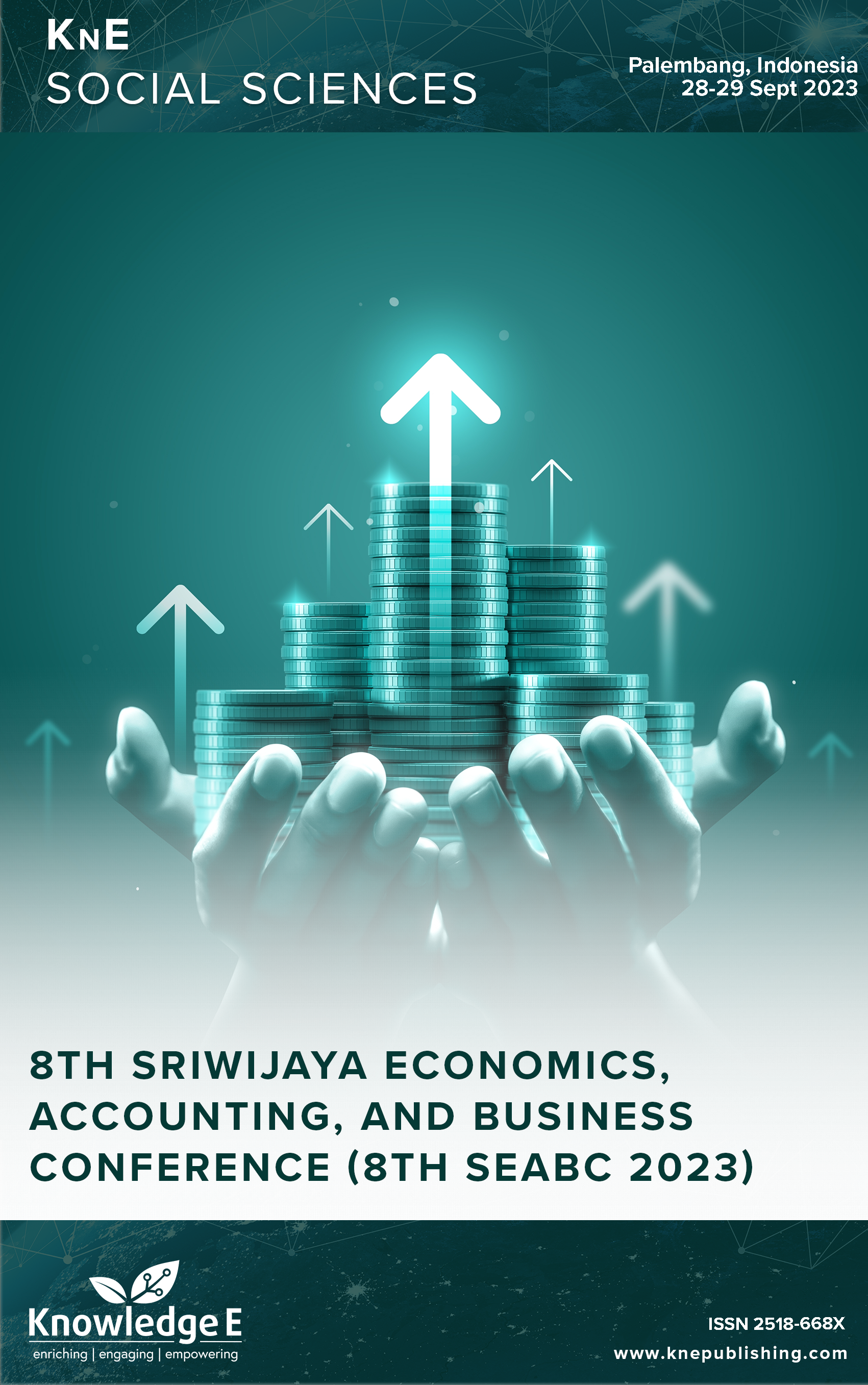The Impact of Educational Conditions on Income Inequality and Economic Growth in South Sumatra
DOI:
https://doi.org/10.18502/kss.v9i14.16104Abstract
Before and during the COVID-19 pandemic, income inequality and economic growth in South Sumatra experienced fluctuating conditions that could hinder learning and education activities. This study aims to examine the effect of educational conditions, consisting of the average length of school (RLS), literacy rate (AMH), pure participation rate (APM), and percentage of 15+ population of senior high school level (PPTP) on income inequality and economic growth in South Sumatra. Data were obtained from the BPS-Statistics of South Sumatra. The current study implemented panel data regression analysis on cross-sectional data from 16 cities/regencies in South Sumatra and time series 2017–2021. The research findings in the first equation show that RLS has a significant effect on reducing income inequality. AMH, APM, and PPTP do not significantly reduce income inequality. The second equation shows that APM and PPTP have a significant effect on economic growth, while RLS and AMH have no significant effect on economic growth. The influence of education on several of these factors has not reduced income inequality and economic growth caused by the COVID-19 pandemic. Apart from that, the APBD’s focus has been redirected to coping with the COVID-19 case; therefore, education has received less attention for this condition. Regional government efforts need to be increased by utilizing school operational assistance for people experiencing poverty and increasing the allocation of education funds above 20% so that compulsory education becomes 12 years.
Keywords: COVID-19, economic growth, income inequality, length of school average, pure participation rate
References
Frederich R, Nurhayati, Purba SF, Nurhayati, Purba SF. Peranan Pendidikan dalam Meningkatkan Pertumbuhan Ekonomi di Indonesia. Jurnal Ilmiah Ekonomi Bisnis. 2023;28(1):69–83. DOI: https://doi.org/10.35760/eb.2023.v28i1.7227
Todaro MP, Smith SC. Economic development. 11th ed. New York: Pearson; 2012.
Mankiw NG. Macroeconomics. 9th ed. New York: Worth Publisher; 2016.
BPS-Statistics of South Sumatera. GRDP per Capita at 2010 Constant Market Price by Regency/Municipality, 2015-2022. Palembang: BPS-Statistics of South Sumatera; 2023.
BPS-Statistics of South Sumatera. Gini Ratio by Regency/Municipality, 2011–2022. Palembang: BPS-Statistics of South Sumatera; 2023.
Nugrahadi E, Suharianto J, Priyono A. Challenges of the Industrial Revolution 4.0 on the education of the poor case study: Disparities education on length of schools in Sumatera. Proceedings of the Proceedings of the 2nd International Conference of Science Education in Industrial Revolution 4.0, ICONSEIR, December 17th,2019, Medan, North Sumatra, Indonesia. 2020, June 4. 17-12-2019:2296034. https://doi.org/https://doi.org/10.4108/eai DOI: https://doi.org/10.4108/eai.17-12-2019.2296034
Aqil HM, Wahyuniati D. (2022). the effect of human capital inequality on income inequality: Evidence from Indonesia. Proceedings of The International Conference on Data Science and Official Statistics. 2021(1):358–372. DOI: https://doi.org/10.34123/icdsos.v2021i1.63
Coady D, Dizioli A. Income inequality and education revisited: Persistence, endogeneity, and heterogeneity (WP/17/126). 2017. DOI: https://doi.org/10.5089/9781475595741.001
Gabrieli C. How longer school days can fight the effects of income inequality. The Boston Blobe; 2016. https://www.bostonglobe.com/magazine/2016/04/05/owepublic- school-students-longer-days/VRc83V9EHcXvXDvtV9WobO/story.html
Messias E. Income inequality, illiteracy rate, and life expectancy in Brazil. Am J Public Health. 2003;93(8):1294–1296. DOI: https://doi.org/10.2105/AJPH.93.8.1294
Shahabadi A, Nemati M, Hosseinidoust SE. The effect of education on income inequality in selected Islamic countries. International Journal of Asia Pacific Studies. 2018;14(2):61–78. DOI: https://doi.org/10.21315/ijaps2018.14.2.3
Wahyuni RN, Monika AK. Pengaruh Pendidikan Terhadap Ketimpangan Pendapatan Tenaga Kerja di Indonesia. Jurnal Kependudukan Indonesia. 2017;11(1):15. DOI: https://doi.org/10.14203/jki.v11i1.63
Budiono S, Purba J. Economic growth through educational participation and clean water: The case from 500 districts and cities in Indonesia. Proceedings of the Proceedings of The First International Conference on Global Innovation and Trends in Economy, InCoGITE. 7 November 2019, Tangerang, Banten, Indonesia. 2022, March 23. https://doi.org/10.4108/eai.7-11-2019.2295252 DOI: https://doi.org/10.4108/eai.7-11-2019.2295252
Ezkirianto R, Alexandi, M F. Analysis of the linkage between the Human Development Index and GRDP per capita in Indonesia. Jurnal Ekonomi dan Kebijakan Pembangunan. 2018;2(1):14–29. https://doi.org/10.29244/jekp.2.1.2013.14- 29 DOI: https://doi.org/10.29244/jekp.2.1.14-29
Hepi H, Zakiah W. Influence of life expectancy rate and old school rate to GRDP percapita and economic growth in central Kalimantan Province 2011–2015. Journal Magister Ilmu Ekonomi Universitas Palangka Raya: GROWTH. 2018;4(1):56–68. DOI: https://doi.org/10.52300/grow.v4i1.2277
Reza F, Widodo T. The impact of education on economic growth in Indonesia. Journal of Indonesian Economy and Business. 2013;28(1):23–44. https://doi.org/https://doi.org/10.22146/jieb.6228
Van GG, Costa MT. An econometric study of the impact of education on the economic development of low-income countries. 2021.
Cadil J, Petkovová L, Blatná D. Human capital, economic structure and growth. Procedia Econ Finance. 2014;12:85–92. DOI: https://doi.org/10.1016/S2212-5671(14)00323-2
Sari Y, Soleh A, Wafiaziza W. Analisis Pengaruh Pendidikan dan Penduduk Miskin Terhadap Ketimpangan Pendapatan di Provinsi Jambi. Journal Development. 2021;9(2):169–180. DOI: https://doi.org/10.53978/jd.v9i2.182
Giri NK, Yasa PN, Jayawarsa A A K. The influence of the components of the Human Development Index on the economic growth of cities/regencies in Bali in 2012-2019 [WEDJ]. Warmadewa Economic Development Journal. 2022;5(2):31–39. DOI: https://doi.org/10.22225/wedj.5.2.2022.31-39
Marquez-Ramos L, Mourelle E. Education and economic growth: An empirical analysis of nonlinearities. Applied Economic Analysis. 2019;27(79):21–45. DOI: https://doi.org/10.1108/AEA-06-2019-0005
Yeoh EK, Chu KM. Literacy, education and economic development in contemporary China. SSRN Electronic Journal. 2012;2(1):11– 83. https://doi.org/10.2139/ssrn.2207559 DOI: https://doi.org/10.2139/ssrn.2207559
Gujarati D, Porter D, Gunasekar S. Basic econometrics. 5th ed. McGraw Hill Education; 2017.
BPS-Statistics of West Jawa. Pure participation rate, 2006–2021. Palembang: BPSStatistics of South Sumatera; 2022.
Apostu SA, Mukli L, Panait M, Gigauri I, Hysa E. Economic growth through the lenses of education, entrepreneurship, and innovation. Adm Sci. 2022;12(3):74. DOI: https://doi.org/10.3390/admsci12030074
Liu X, Li D. Analysis of the V.A.R. as a tool to investigate the impact of higher education on economic growth in Macau in the period 2000–2019. Ekon Istraz. 2023;36(2):1–15. DOI: https://doi.org/10.1080/1331677X.2023.2171453
Sukirno S. Makroekonomi: Pengantar Teori. Raja Grafindo Persindo; 2006.
Almutairi NT. Does investment in Human Capital via education stimulate economic growth in an oil-rich country? A case study of Saudi Arabia. J Knowl Econ. 2023:1–23. DOI: https://doi.org/10.1007/s13132-023-01265-1

